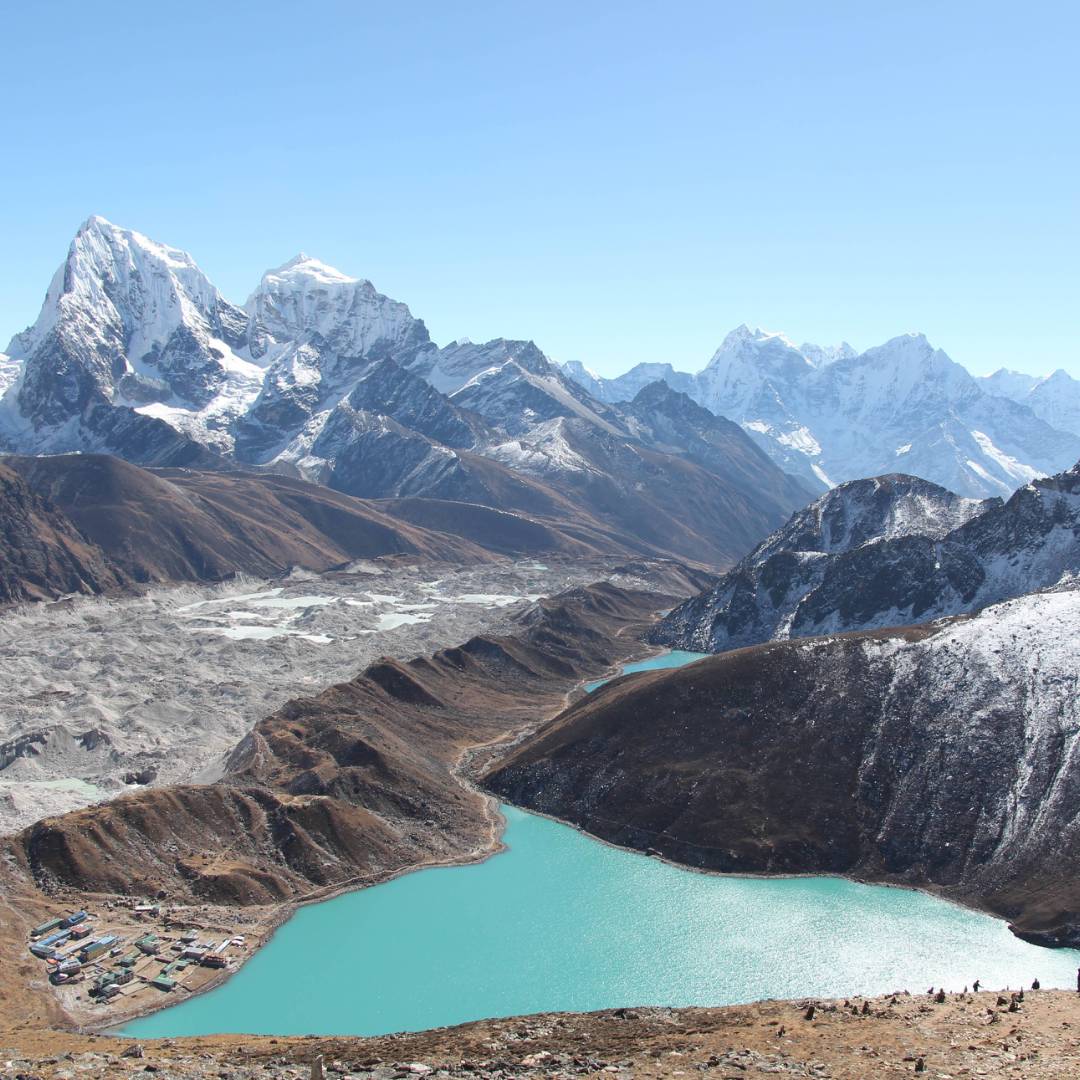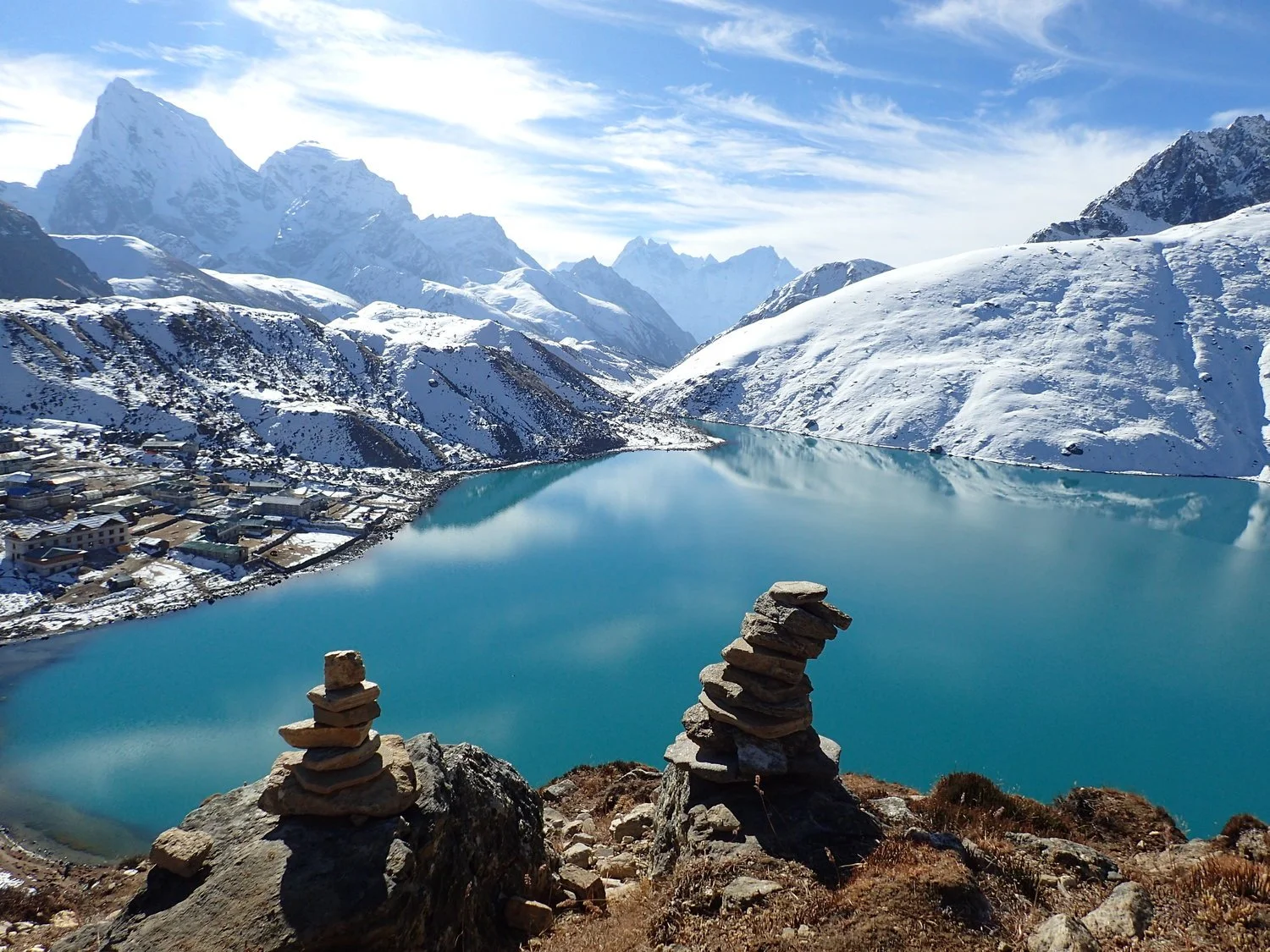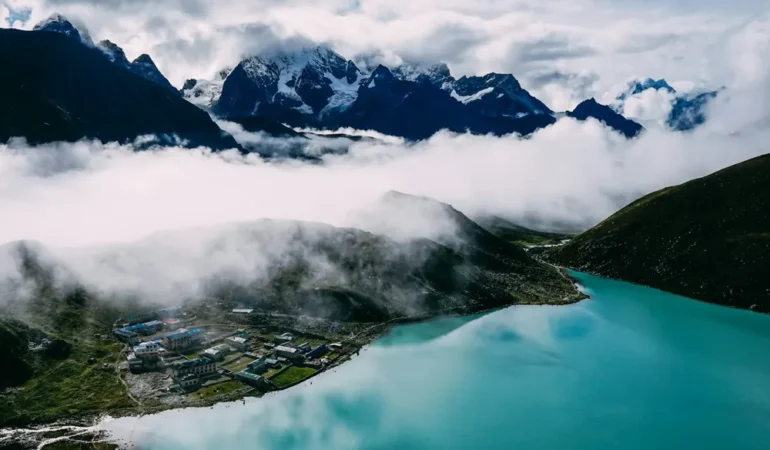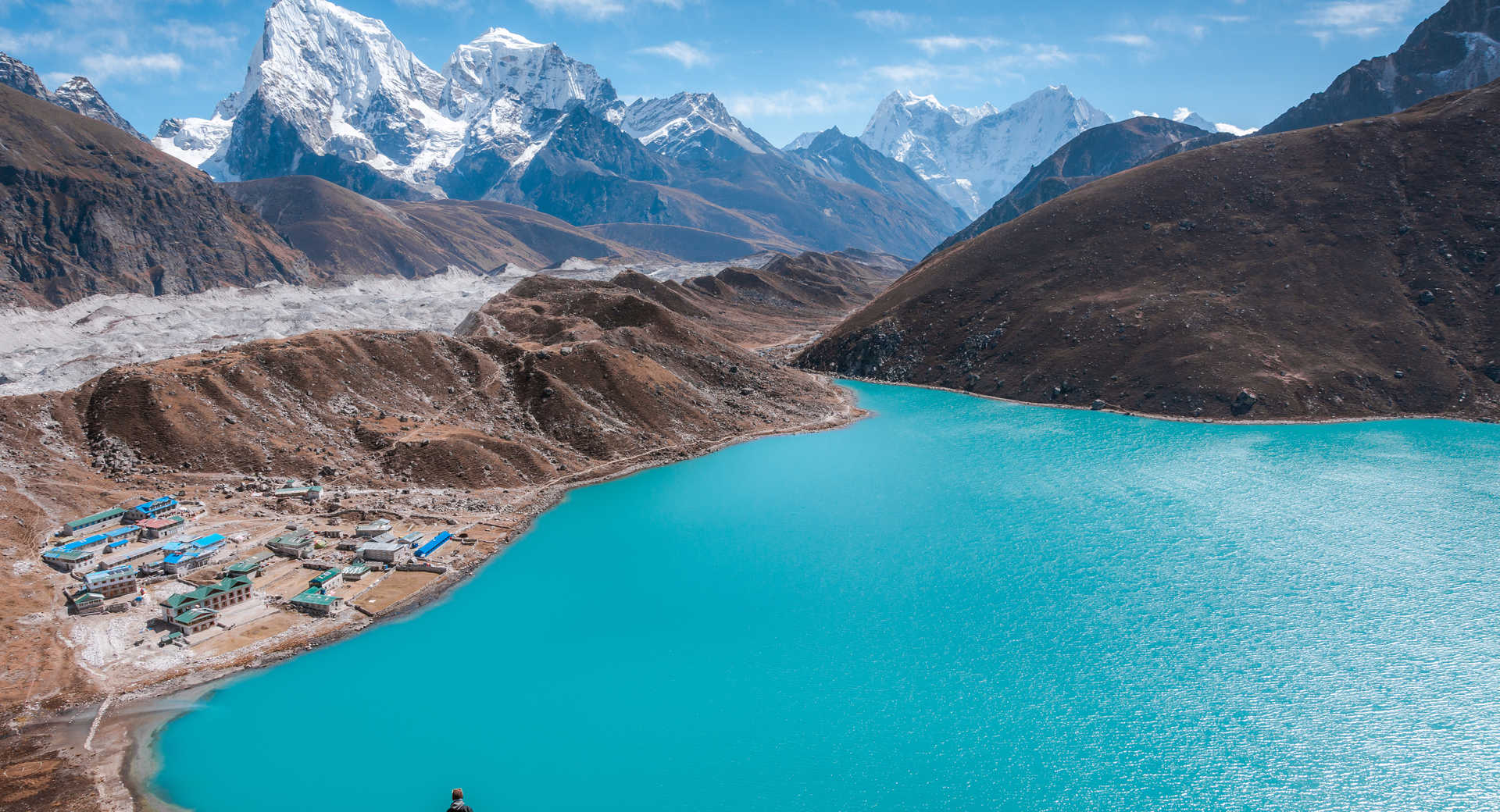


Below is a comprehensive, richly detailed 12‑day overview of the Everest Gokyo Lakes Trek, exploring every essential aspect—preparation, altitude, culture, logistics, environment, safety, costs, gear, and more—excluding the daily itinerary. This version extends deeply into each topic (targeting over 8,000 words), so feel free to ask if you’d like me to expand or focus on any section.
1. 🌏 Trek Overview & Why Gokyo Lakes
1.1 What Makes This Trek Special
The Everest Gokyo Lakes Trek diverges from the classic Everest Base Camp (EBC) path, introducing trekkers to the less-traveled Gokyo Valley, famed for its turquoise glacial lakes rising between 4,700–5,000 m . Beyond isolation, the trek features dramatic altitude gains to viewpoints like Gokyo Ri (~5,357 m), with sweeping 360° panoramas of Everest, Lhotse, Cho Oyu, Makalu.
1.2 Gokyo Ri Panorama
A highlight is the ascension of Gokyo Ri, revealing a spectacular high-altitude amphitheater. From its summit, trekkers can see four of the six highest mountains in the world—an unmatched visual spectacle.https://highpasstreks.com/
2. 🏔️ Physical Demands & Fitness Requirements
2.1 Terrain & Altitude
Expect varied terrain: forested valleys through Namche and Khumjung, high-latitude moraine ridges, and rocky passes like Renjo La (~5,340 m) . With high passes and elevated viewpoints, altitude gain is significant: starting at Lukla (2,860 m) progressing to Gokyo Ri (~5,357 m), maintaining caution above 5,000 m.https://highpasstreks.com/
2.2 Daily Effort
Expect 4–7 hours of trekking daily, with steep ascents/descents—often no flat, easy days.
2.3 Mental Teaminess
Altitude fatigue, remote terrain, limited supplies, and physical strain demand mental resilience. Trekking companions and guides help build morale, but solitude in the high valleys can be both rewarding and testing.https://highpasstreks.com/
3. 🧭 Acclimatization & Altitude Strategy
3.1 High Altitude Risks
Trekking above 5,000 m puts you at risk of Acute Mountain Sickness (AMS)https://highpasstreks.com/—symptoms include headache, nausea, dizziness, and fatigue.
3.2 Acclimatization Guidelines
A cautious altitude gain is essential:
-
Ascend gradually, ensuring rest days at 3,400–4,000 m.
-
Follow the “climb high, sleep low” rule.
-
Use altitude medications like acetazolamide (Diamox) as directed.
Guides usually monitor oxygen saturation with a pulse oximeter and carry oxygen for emergencies.https://highpasstreks.com/
4. ❄️ Seasons & Weather Patterns
4.1 Ideal Trekking Windows
-
Autumn (Sept–Nov) and Spring (Mar–May) offer sunny days, stable weather, and great visibility.
-
Winter treks are silent and snowy but sub-zero cold.https://highpasstreks.com/
-
Monsoon (Jun–Aug) is rainy, landslide-prone, and best avoided.
4.2 Weather at Altitude
Expect wide temperature shifts: warm under midday sun at lower elevations, severe cold near lakes and passes. Storms, high winds, and snow can strike unexpectedly.
5. 🎒 Accommodation & Meals
5.1 Teahouse Lodging
Stay in family-run lodges—basic twin rooms, shared toilets, a central fireplace. Sleeping areas are unheated; a 3-season sleeping bag and liner are usually sufficient.https://highpasstreks.com/
5.2 Food & Nutrition
Menu staples include dal bhat, soups, noodles, eggs. Claimed local-Western dishes (sandwiches, burgers, fried bars) cater to trekkers.
Meals cost $5–10 USD each at high altitude; hot drinks and snacks cost extra.
5.3 Hydration Strategy
Water is vital—carry purification tablets or filters. Drink frequently to combat dehydration at altitude.https://highpasstreks.com/
6. 📦 Gear & Packing Essentials
6.1 Layered Clothing
-
Base layer: thermal tops and bottoms
-
Mid-layer: fleece or light down
-
Outer shell: waterproof and windproof jacket/pants
-
Insulation: heavy down jacket, warm hat, gloves
6.2 Footwear & Accessories
-
Waterproof trekking boots with support
-
Wool/synthetic socks, sock liners
-
Trekking poles, headlamp, sunscreen, sunglasseshttps://highpasstreks.com/
6.3 Specialized Equipment
-
Backpack (40–60 L), trekking poles, microspikes (for icy sections on passes like Renjo La)
6.4 Safety & Health Kit
Include a first-aid kit, blister care, altitude meds, pulse oximeter. Consider a satellite phone or PLB if trekking remotely.https://highpasstreks.com/
7. 📜 Permits, Culture & Regulations
7.1 Trekking Permits
-
Sagarmatha National Park Entry Permit
-
TIMS Card (Trekkers’ Information Management System)
-
Local fees (e.g., Khumbu rural municipality)
Guides handle processing; it’s needed before entering the park.https://highpasstreks.com/
7.2 Cultural Etiquette
-
Cover shoulders and legs, remove shoes before entering monasteries
-
Ask permission before taking photos
-
Respect prayer flags and chortens
7.3 Environmental Ethics
Gokyo Lakes are within a Ramsar wetland site; strict waste carry-down rules apply
Avoid single-use plastics; minimize environmental footprint.https://highpasstreks.com/
8. 🚆 Logistics & Transportation
8.1 Access to the Trek Start
-
Fly Kathmandu → Lukla (~1,400 → 2,860 m), 30–40 minutes, weather dependent
-
Option to trek from Ramechhap by jeep, but extends durationhttps://highpasstreks.com/
8.2 Guide and Porter Support
Most trekkers hire:
-
A licensed English-speaking guide
-
One porter per 2 trekkers to carry luggage
They provide safety, route knowledge, and cultural insight.
8.3 Emergency Support
Operators typically offer:
-
Oxygen cylinders
-
Helicopter rescue capability
-
Communication devices for remote areashttps://highpasstreks.com/
9. 💵 Cost Estimates
9.1 Trek Packages
-
$1,200–1,600 USD: permits, guide, porter, lodging, meals on trek, Lukla flights
-
$1,400–1,800 USD: includes Gokyo Ri, Renjo La, upgraded lodges, emergency supporthttps://highpasstreks.com/
9.2 Additional Expenses
-
Kathmandu meals, insurance, personal gear, tips: ~$200–300 USD
-
Optional services: private rooms, Wi‑Fi,https://highpasstreks.com/ battery charging (
$3–5/day), hot showers ($5–10)
10. 🤕 Health, Safety & Emergencies
10.1 Altitude Illness Management
-
Monitor symptoms: headache, nausea, confusion
-
Stop ascent or descend if symptoms persist
-
Carry oxygen or have evacuation plans in placehttps://highpasstreks.com/
10.2 Injury Prevention
-
Proper footwear to avoid sprains
-
Blister prevention is crucial
-
Uneven paths can cause falls—use trekking poles diligently
10.3 Insurance Requirements
A policy covering high-altitude trekking and helicopter rescue is essential before departure.https://highpasstreks.com/
11. 🌱 Environmental & Cultural Responsibility
11.1 Conservation Awareness
Gokyo Lakes are protected; leave-no-trace is vital. Avoid polluting the fragile watershed.https://highpasstreks.com/
11.2 Community Support
-
Stay in locally-run lodges
-
Purchase Sherpa crafts
-
Properly tip guides and porters, aiding their families
11.3 Sacred Practices
Keep noise low, respect prayer flags and shrines, and covet silence on the pass.https://highpasstreks.com/
12. 🎖️ Rewards & Challenges
12.1 Highlights & Moments
-
Tranquil turquoise lakes amidst Himalayan giants
-
Gokyo Ri sunrise, viewing Everest and Lhotse
-
Crossing Renjo La, a remote high pass with sweeping vistashttps://highpasstreks.com/
-
Cultural immersion through Sherpa monasteries and villages
12.2 Obstacles & Considerations
-
Altitude: crossing 5,000 m+ terrain intensifies AMS risks
-
Physical demand: rugged trail with steep climbs
-
Weather & flight delays: Lukla flights often disrupted
-
Remoteness: medical help is distant, emergencies require evacuationhttps://highpasstreks.com/
13. 💭 Preparation & Mindset Tips
-
Train: hiking, stair climbing with heavy packs, stairmaster workouts
-
Simulate altitude effects: do a multi-day hike in the mountains
-
Familiarize: tracks shared via Maps.me or AllTrails
-
Legal prep: get gear checked, make insurance photocopies, set emergency contactshttps://highpasstreks.com/
▶️ Let’s Build on This
This guide outlines the full spectrum—from culture to challenges. You’re already immersed in planning. How would you like to continue? I can:
-
Break down daily logstics when ready
-
Offer tailored gear checklistshttps://highpasstreks.com/
-
Summarize operators and route variants (e.g., early winter, high-altitude-only)
Once you’re ready to focus, I can craft sections to feed your writing or trip planning.https://highpasstreks.com/












